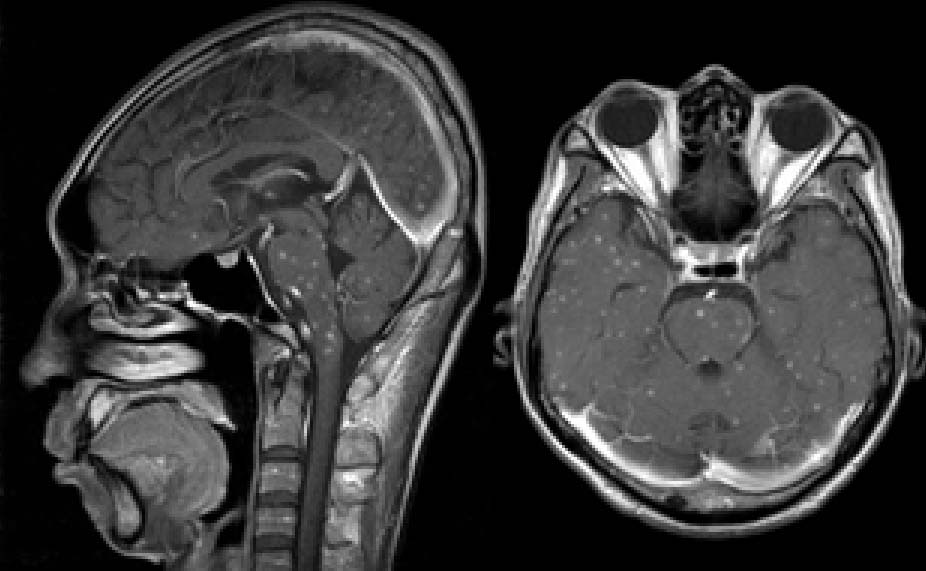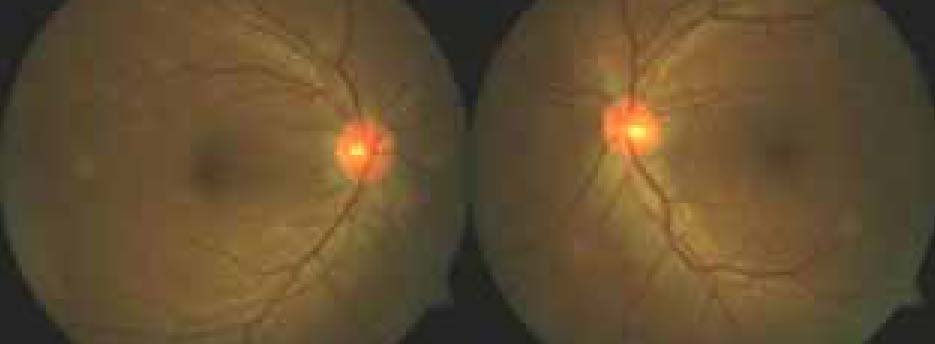Infect Chemother.
2008 Dec;40(6):323-326. 10.3947/ic.2008.40.6.323.
A Case of Disseminated Tuberculosis with Miliary Central Nervous System Tuberculoma
- Affiliations
-
- 1Department of Internal Medicine, Korea University College of Medicine, Seoul, Korea. heejinmd@medimail.co.kr
- 2Department of Internal Medicine, Hallym University College of Medicine, Seoul, Korea.
- KMID: 1782298
- DOI: http://doi.org/10.3947/ic.2008.40.6.323
Abstract
- Disseminated tuberculosis occurs through lymphohematogenous dissemination of Mycobacterium tuberculosis bacilli. The exact incidence of disseminated tuberculosis is still unknown and its diagnosis presents a challenge since the symptoms are not specific of the disease. Brain tuberculoma is one of the complications of tuberculosis. The literary review of brain tuberculoma shows that it mainly occurs in the cerebrum and cerebellum, whereas involvement of the brainstem is rare. Recently, we have experienced a case of 46-year-old man with fever of 2 months duration who was diagnosed with disseminated tuberculosis with miliary central nervous system (CNS) tuberculomas; brain tuberculomas were found even in the brainstem and the spinal cord. Pulmonary, intestinal, renal, and choroidal involvements were also noted.
MeSH Terms
Figure
Reference
-
1. Chin C, Lee SS, Chen YS, Wann SR, Lin HH, Lin WR, Huang CK, Kao CH, Yen MY, Liu YC. Mycobacteriosis in patients with fever of unknown origin. J Microbiol Immunol Infect. 2003. 36:248–253.2. Tabak F, Mert A, Celik AD, Ozaras R, Altiparmak MR, Ozturk R, Aktuglu Y. Fever of unknown origin in Turkey. Infection. 2003. 31:417–420.3. Colpan A, Onguru P, Erbay A, Akinci E, Cevik MA, Eren SS, Bodur H. Fever of unknown origin: analysis of 71 consecutive cases. Am J Med Sci. 2007. 334:92–96.
Article4. Wang JY, Hsueh PR, Wang SK, Jan IS, Lee LN, Liaw YS, Yang PC, Luh KT. Disseminated tuberculosis: a 10-year experience in a medical center. Medicine (Baltimore). 2007. 86:39–46.5. Kim YK, Kim MS, Lee KS, Huh AJ, Yeom JS, Hong SK, Chang KH, Song YG, Kim JM. A comparison of causes of fever of unknown origin between the 1980s and the 1990s. Korean J Med. 2001. 61:546–552.6. Kee SY, Jo YM, Kim JY, Choi WS, Jeong HW, Jung SJ, Kim SB, Hyun JJ, Hwang BY, Cheong HJ, Kim WJ. Etiology of Adult Patients with Fever of Unknown Origin (FUO) Observed in A University Hospital in Korea from 1998-2003. Infect Chemother. 2005. 37:127–132.7. Arrow PM, Flaherty JP. Fever of unknown origin. Lancet. 1997. 350:575–580.
Article8. Guzel A, Tatli M, Aluclu U, Yalcin K. Intracranial multiple tuberculomas: 2 unusual cases. Surg Neurol. 2005. 64:Suppl 2. S109–S112.
Article9. Idris MN, Sokrab TE, Arbab MA, Ahmed AE, El Rasoul H, Ali S, Elzubair MA, Mirgani SM. Tuberculoma of the brain: a series of 16 cases treated with anti-tuberculosis drugs. Int J Tuberc Lung Dis. 2007. 11:91–95.10. Varma D, Anand S, Reddy AR, Das A, Watson JP, Currie DC, Sutcliffe I, Backhouse OC. Tuberculosis: an under-diagnosed aetiological agent in uveitis with an effective treatment. Eye. 2006. 20:1068–1073.
Article11. Diagnostic Standards and Classification of Tuberculosis in Adults and Children. This official statement of the American Thoracic Society and the Centers for Disease Control and Prevention was adopted by the ATS Board of Directors, July 1999. This statement was endorsed by the Council of the Infectious Disease Society of America, September 1999. Am J Respir Crit Care Med. 2000. 161:1376–1395.12. Rodrguez L, Graniel J, Ortiz R. Effect of leptin on activation and cytokine synthesis in peripheral blood lymphocytes of malnourished infected children. Clin Exp Immunol. 2007. 148:478–485.
Article13. Pavia CS, La Mothe M, Kavanagh M. Influence of alcohol on antimicrobial immunity. Biomed Pharmacother. 2004. 58:84–89.
Article14. Prasad K, Singh MB. Corticosteroids for managing tuberculous meningitis. Cochrane Database Syst Rev. 2008. 23:CD002244.
Article15. Thwaites GE, Nguyen DB, Nguyen HD, Hoang TQ, Do TT, Nguyen TC, Nguyen QH, Nguyen TT, Nguyen NH, Nguyen TN, Nguyen NL, Nguyen HD, Vu NT, Cao HH, Tran TH, Pham PM, Nguyen TD, Stepniewska K, White NJ, Tran TH, Farrar JJ. Dexamethasone for the treatment of tuberculous meningitis in adolescents and adults. N Engl J Med. 2004. 351:1741–1751.
- Full Text Links
- Actions
-
Cited
- CITED
-
- Close
- Share
- Similar articles
-
- En Plaque Tuberculoma: a Case Report
- Multiple Tuberculoma Involving the Brain and Spinal Cord in a Patient with Miliary Pulmonary Tuberculosis
- Miliary Tuberculosis and Multiple Intracranial Tuberculoma : A Case Report
- Disseminated Tuberculosis of Central Nervous System : Spinal Intramedullary and Intracranial Tuberculomas
- A Case of Intracranial Tuberculoma and Optic Disc Tuberculoma Suspected by Miliary Tuberculosis




